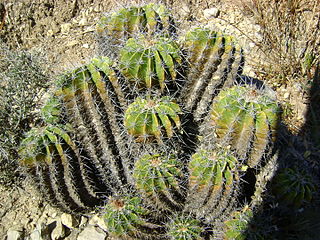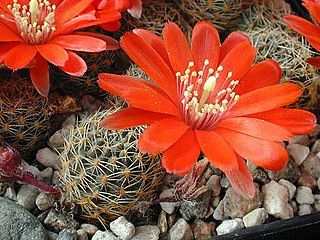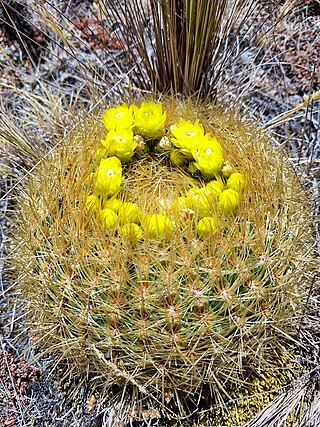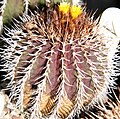
Gymnocalycium, commonly called chin cactus, is a genus of about 70 South American species of cactus. The genus name Gymnocalycium refers to the flower buds bearing no hair or spines.

Cleistocactus is a genus of flowering plants in the cactus family Cactaceae, native to mountainous areas - to 3,000 m (9,843 ft) - of South America. The name comes from the Greek kleistos meaning closed because the flowers hardly open.

Echinocereus is a genus of ribbed, usually small to medium-sized, cylindrical shaped cacti, comprising about 70 species native to the southern United States and Mexico in very sunny, rocky places. Usually the flowers are large and the fruit edible.

Pediocactus is a genus of cacti. The genus comprises between 6 and 11 species, depending upon the authority. Species of this genus are referred to as hedgehog cacti, though that name is also applied to plants from the genera Echinocereus and Echinopsis. Species may also be referred to as pincushion cacti, a common name which is also applied to other genera.

Parodia is a genus of flowering plants in the family Cactaceae, native to the eastern slopes of the Andes in northwestern Argentina and southwestern Bolivia and in the lowland pampas regions of northeastern Argentina, southern Brazil, eastern Paraguay, and Uruguay. This genus has about 65 species, many of which have been transferred from Eriocactus, Notocactus and Wigginsia. They range from small globose plants to 1 m (3 ft) tall columnar cacti. All are deeply ribbed and spiny, with single flowers at or near the crown. Some species produce offsets at the base. They are popular in cultivation, but must be grown indoors where temperatures fall below 10 °C (50 °F).

Mitrocereus is a monotypic genus of cacti. Its sole species is Mitrocereus militaris, native to Mexico.

Arthrocereus is a genus of cactus, native to southeast and west-central Brazil.

Discocactus is a genus of tropical cacti. Discocactus plants are endemic to southern Brazil, eastern Bolivia, and northern Paraguay. These species are in the risk of extinction in the wild.

Espostoopsis is a monotypic genus of cactus containing the single species Espostoopsis dybowskii. The generic name is formed from Greek opsis meaning "view", referring to its resemblance to the genus Espostoa, with which it is often confused. The plant is only known from northern Bahia, Brazil.

Haageocereus is a genus of cacti endemic to the lower elevations of the extremely dry desert along the coast of Peru and northern Chile.

Samaipaticereus is a monotypic genus of cactus containing the sole species Samaipaticereus corroanus. It is known only from East Andean Bolivia and Peru.

Ferocactus glaucescens, the glaucous barrel cactus, is a species of flowering plant in the family Cactaceae, native endemic to México.

Lophocereus marginatus is a species of plant in the family Cactaceae. It is sometimes called Mexican fencepost cactus.

Soehrensia thelegona is a species of cactus in the Soehrensia genus.

Parodia ottonis, also known as Indian head cactus, is a cactus found in Argentina, Brazil, Paraguay and Uruguay. There are two recognized subspecies. The epithet ottonis honors the German botanist Christoph Friedrich Otto.

Ferocactus flavovirens is a species of Ferocactus from Mexico.

Acanthocalycium thionanthum is a species of Acanthocalycium from Argentina.

Oreocereus trollii, commonly known as the Old Man of the Andes cactus, is a species of cacti native to Argentina and Bolivia. Though listed as Least Concern by the IUCN, the plant is collected extensively, and in some areas is threatened.

Aylostera pygmaea, synonyms including Rebutia pygmaea, is a species of cactus in the genus Aylostera, native to Bolivia and northwest Argentina. It has gained the Royal Horticultural Society's Award of Garden Merit.

Oroya borchersii is a species of cacti, originating from Peru























